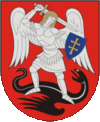Nemenčinė
| Nemenčinė | ||
|---|---|---|
| City | ||

Nemenčinė old city streets
|
||
|
||
| Location of Nemenčinė | ||
| Coordinates: 54°51′0″N 25°29′0″E / 54.85000°N 25.48333°ECoordinates: 54°51′0″N 25°29′0″E / 54.85000°N 25.48333°E | ||
| Country |
|
|
| Ethnographic region | Aukštaitija | |
| County | Vilnius County | |
| Municipality | Vilnius district municipality | |
| Eldership | Nemenčinė eldership | |
| Capital of | Nemenčinė eldership | |
| First mentioned | 14th century | |
| Granted city rights | 1955 | |
| Population (2011 Census) | ||
| • Total | 5,054 | |
| Time zone | EET (UTC+2) | |
| • Summer (DST) | EEST (UTC+3) | |
Nemenčinė (![]() Nemenčinė , see names section for alternate and historic names) is a city in Vilnius district municipality, Lithuania, it is located about 20 kilometres (12 mi) north-east of Vilnius.
Nemenčinė , see names section for alternate and historic names) is a city in Vilnius district municipality, Lithuania, it is located about 20 kilometres (12 mi) north-east of Vilnius.
Nemenčinė is the original name of the city reflected in historical documents and still in use today. It derives from a Lithuanian word referring to the river Nemenčia. Other versions of the name include Неменчын in Belarusian, Niemenczyn in Polish, Неменчине (or Нямянчине) in Russian, Nementschine in German and Nementchin (נעמענטשין) in Yiddish.
In 1387, following the Christianization of Lithuania, Jogaila established the first Christian parish in Nemenčinė and built a church there.
On September 20, 1941, 403 Jews from the city were massacred in a mass execution. 128 men, 186 women and 99 children were shot by an Einsatzgruppen of Lithuanian Nazis. Today, there is a memorial on the execution site.
The ethnic composition of Nemenčinė is as follows:
Total population in 2011 – 5054
Nemenčinė is twinned with three towns in Poland: Węgorzewo (Ungura), Ełk (Lukas) and Suwałki. It also has a partnership agreement with Poland's West Pomeranian Voivodeship, signed in Vilnius on 19 June 2009.
...
Wikipedia


